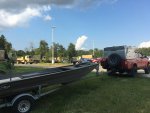coming from 17feet amsl, i really need an overnight at 8500 amsl to be comfortable at 10k and above. the previous page foto at 10.5k i woke up with a headache. the wind blew all night and was stronger in the morning, I was still able to close the Habitat. I'd planned to stay at 7.5k just down the road, but it was too hot at 1400hrs, so drove to the top to the site pictured, much cooler with passing thunder showers and increasing wind.
I can't imagine an oxygen concentrator doing any concentrating at high colorado altitudes
There are portable oxygen concentrators rated to up to 13,123, or 4,000 meters. That's a pretty specific altitude.
So a little more on how most oxygen concentrators actually work. They typically use the method of adsorption, think of a sieve but for Earth's nitrogen/oxygen atmosphere. Practically all oxygen concentrators use this method. Back to the mechanics, a typical oxygen concentrator uses an air compressor, two cylinders filled with zeolite (the adsorbent), some tubes, some valves, some nozzles, a casing, a power supply, and some fittings for a canula.
Literally that's all it is in that package.
So what's the secret sauce inside an O2 Concentrator? The Zeolite. This Adsorption media basically attracts all the nitrogen out of the air, it's similar to how a sponge sucks up water in our atmosphere. But wait a second, what happens when it sucks up so much nitrogen that all the pores are full? This is why there are two cylinders.
As the compressor runs and brings the pressure to about 2 atmospheres, the pressurised air is directed towards one cylinder. Atmospheric Oxygen passes through the cylinder leaving behind the Nitrogen trapped in the zeolite until the zeolite adsorber is saturated with Nitrogen and no longer lets out pure O2. When this happens, after a few seconds, a valve redirects the pressurised air from the compressor it to a secondary cylinder. During these few seconds that the secondary cylinder is utilized, the first cylinder's adsorbent is being purged of nitrogen when it is vented and returned to ambient atmospheric pressure.
The effectiveness and efficiency of this type of oxygen concentrator depends heavily on a clean source of consistently pressurised air. In higher altitudes, due to lower pressure and small compressor, the companies cannot guarantee that the output will be 91% pure O2 and the batteries won't last long because the compressor is running continuously. But hey, we're tied to our trucks, and we have tons of power and we just need more O2 than what's available at say... 18,000 feet where the Guallatiri Volcano is in the Atacama Desert. :snorkel:
Reading on air compressors, compressor effectiveness is degraded roughly between 4-4.5% per 1,000 feet. at 20,000 feet, that's losing like 80% of the compressor's effectiveness.
I bet an Air Zenith OB2 connected to a 2.5 gallon tank and a oil/water separator should be able to do the job.








